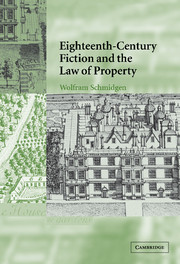Book contents
- Frontmatter
- Contents
- Acknowledgments
- Introduction
- 1 Communal form and the transitional culture of the eighteenth-century novel
- 2 Terra nullius, cannibalism, and the natural law of appropriation in Robinson Crusoe
- 3 Henry Fielding and the common law of plenitude
- 4 Commodity fetishism in heterogeneous spaces
- 5 Ann Radcliffe and the political economy of Gothic space
- 6 Scottish law and Waverley's museum of property
- Conclusion
- Notes
- Bibliography
- Index
5 - Ann Radcliffe and the political economy of Gothic space
Published online by Cambridge University Press: 22 September 2009
- Frontmatter
- Contents
- Acknowledgments
- Introduction
- 1 Communal form and the transitional culture of the eighteenth-century novel
- 2 Terra nullius, cannibalism, and the natural law of appropriation in Robinson Crusoe
- 3 Henry Fielding and the common law of plenitude
- 4 Commodity fetishism in heterogeneous spaces
- 5 Ann Radcliffe and the political economy of Gothic space
- 6 Scottish law and Waverley's museum of property
- Conclusion
- Notes
- Bibliography
- Index
Summary
Students of the eighteenth-century novel have been strongly impressed with the architectural qualities of Tom Jones. Ever since, in 1953, Dorothy van Ghent compared the structure of Henry Fielding's novel to a Palladian mansion, many have been intrigued by a metaphor that seems so appropriate to the self-conscious constructedness of Fielding's fictional world. But critics such as van Ghent, Frederick Hilles, Martin Battestin, and J. Paul Hunter may have been too eager to include Tom Jones in an Augustan canon. Their Palladian analogy has at least obscured the fact that Fielding's archetypal English manor is not crowned by a neoroman villa, but by a Gothic mansion, an architectural style extremely compatible, as Fielding's friend Hogarth suggested, with the aesthetic of the undulating line that shapes so much of what Fielding does in Tom Jones. If one wants to venture any architectural comparison, the irregular extensions of the Gothic seem much more congenial to Fielding's swerving figurative mode and his mocking of neoclassic regularity in literary structures. Fielding's preference for the Gothic, in fact, is symptomatic in a wider literary-historical sense if such a preference is recognized as a subtext to Ann Radcliffe's Gothic romance and its refiguration of Britain's possessive culture.
Fielding's Paradise Hall stands at the beginning of a period of intensified ideological uses of Gothic architecture. I wish to explore such uses in legal and political discourse in order to shed some light on what interpretations of Radcliffe's novels have left by and large in the dark: the historical significance of the Gothic castle.
- Type
- Chapter
- Information
- Eighteenth-Century Fiction and the Law of Property , pp. 150 - 185Publisher: Cambridge University PressPrint publication year: 2002

